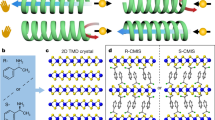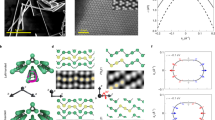Abstract
Chirality—the property of an object wherein it is distinguishable from its mirror image—is of widespread interest in chemistry and biology1,2,3,4,5,6. Regioselective magnetization of one-dimensional semiconductors enables anisotropic magnetism at room temperature, as well as the manipulation of spin polarization—the properties essential for spintronics and quantum computing technology7. To enable oriented magneto-optical functionalities, the growth of magnetic units has to be achieved at targeted locations on a parent nanorod. However, this challenge is yet to be addressed in the case of materials with a large lattice mismatch. Here, we report the regioselective magnetization of nanorods independent of lattice mismatch via buffer intermediate catalytic layers that modify interfacial energetics and promote regioselective growth of otherwise incompatible materials. Using this strategy, we combine materials with distinct lattices, chemical compositions and magnetic properties, that is, a magnetic component (Fe3O4) and a series of semiconducting nanorods absorbing across the ultraviolet and visible spectrum at specific locations. The resulting heteronanorods exhibit optical activity as induced by the location-specific magnetic field. The regioselective magnetization strategy presented here enables a path to designing optically active nanomaterials for chirality and spintronics.
This is a preview of subscription content, access via your institution
Access options
Access Nature and 54 other Nature Portfolio journals
Get Nature+, our best-value online-access subscription
$29.99 / 30 days
cancel any time
Subscribe to this journal
Receive 12 print issues and online access
$259.00 per year
only $21.58 per issue
Buy this article
- Purchase on Springer Link
- Instant access to full article PDF
Prices may be subject to local taxes which are calculated during checkout





Similar content being viewed by others
Data availability
The data are available from the corresponding authors on reasonable request.
References
Berova, N. & Nakanishi, K. in Cicular Dichroism, Principles and Applications (eds Berova, N. et al.) Ch. 8 (Wiley, 1994).
Rikken, G. L. J. A. & Raupach, E. Observation of magneto-chiral dichroism. Nature 390, 493–494 (1997).
Barron, L. D. Chirality and magnetism shake hands. Nat. Mater. 7, 691–692 (2008).
Yin, P., Tan, Y., Fang, H., Hegde, M. & Radovanovic, P. V. Plasmon-induced carrier polarization in semiconductor nanocrystals. Nat. Nanotechnol. 13, 463–467 (2018).
Yeom, J. et al. Chiromagnetic nanoparticles and gels. Science 359, 309–314 (2018).
Gao, X. et al. Distinct excitonic circular dichroism between wurtzite and zincblende CdSe nanoplatelets. Nano Lett. 18, 6665–6671 (2018).
Gao, X. et al. Excitonic eircular dichroism of chiral quantum rods. J. Am. Chem. Soc. 139, 8734–8739 (2017).
Barron, L. D. Molecular Light Scattering and Optical Activity (Cambridge Univ. Press, 2009).
Ma, W. et al. Chiral inorganic nanostructures. Chem. Rev. 117, 8041–8093 (2017).
Gao, X., Han, B., Yang, X. & Tang, Z. Perspective of chiral colloidal semiconductor nanocrystals: opportunity and challenge. J. Am. Chem. Soc. 141, 13700–13707 (2019).
Wu, X. J. et al. Controlled growth of high-density CdS and CdSe nanorod arrays on selective facets of two-dimensional semiconductor nanoplates. Nat. Chem. 8, 470–475 (2016).
Oh, N. et al. Double-heterojunction nanorod light-responsive LEDs for display applications. Science 355, 616–619 (2017).
Tan, C., Chen, J., Wu, X.-J. & Zhang, H. Epitaxial growth of hybrid nanostructures. Nat. Rev. Mater. 3, 17089 (2018).
Zhuang, T.-T. et al. A unique ternary semiconductor–(semiconductor/metal) nano-architecture for efficient photocatalytic hydrogen evolution. Angew. Chem. Int. Ed. Engl. 54, 11495–11500 (2015).
Li, Y. et al. Pulsed axial epitaxy of colloidal quantum dots in nanowires enables facet-selective passivation. Nat. Commun. 9, 4947 (2018).
Laurent, S. et al. Magnetic iron oxide nanoparticles: synthesis, stabilization, vectorization, physicochemical characterizations, and biological applications. Chem. Rev. 108, 2064–2110 (2008).
Ho, D., Sun, X. & Sun, S. Monodisperse magnetic nanoparticles for theranostic applications. Acc. Chem. Res. 44, 875–882 (2011).
Ling, D., Lee, N. & Hyeon, T. Chemical synthesis and assembly of uniformly sized iron oxide nanoparticles for medical applications. Acc. Chem. Res. 48, 1276–1285 (2015).
Lee, J., Yang, J., Kwon, S. G. & Hyeon, T. Nonclassical nucleation and growth of inorganic nanoparticles. Nat. Rev. Mater. 1, 16034 (2016).
Tan, C., Chen, J., Wu, X.-J. & Zhang, H. Epitaxial growth of hybrid nanostructures. Nat. Rev. Mater. 3, 17089 (2018).
Sun, Y. Interfaced heterogeneous nanodimers. Nat. Sci. Rev. 2, 329–348 (2015).
Song, J. et al. Double-layered plasmonic–magnetic vesicles by self-assembly of Janus amphiphilic gold–iron(ii,iii) oxide nanoparticles. Angew. Chem. Int. Ed. Engl. 56, 8110–8114 (2017).
Lou, Z. et al. Anisotropic Ag2S–Au triangular nanoprisms with desired configuration for plasmonic photocatalytic hydrogen generation in visible/near-infrared region. Adv. Funct. Mater. 28, 1706969 (2018).
Logunov, S. L., Ahmadi, T. S., El-Sayed, M. A., Khoury, J. T. & Whetten, R. L. Electron dynamics of passivated gold nanocrystals probed by subpicosecond transient aAbsorption. Spectrosc. J. Phy. Chem. B 101, 3713–3719 (1997).
Rodger, A., Nordén, B. & Nordén, B. Circular Dichroism and Linear Dichroism (Oxford Univ. Press, 1997).
Zhuang, T. T. et al. Controlled synthesis of kinked ultrathin ZnS nanorods/nanowires triggered by chloride ions: a case study. Small 10, 1394–1402 (2014).
Schellman, J. A. Circular dichroism and optical rotation. Chem. Rev. 75, 323–331 (1975).
Han, B., Zhu, Z., Li, Z., Zhang, W. & Tang, Z. Conformation modulated optical activity enhancement in chiral cysteine and Au nanorod assemblies. J. Am. Chem. Soc. 136, 16104–16107 (2014).
Acknowledgements
This work was supported by the National Natural Science Foundation of China (grant nos. 51732011, 21431006, 21761132008, 81788101, 11227901 and 21805188), the Foundation for Innovative Research Groups of the National Natural Science Foundation of China (grant no. 21521001), Key Research Programme of Frontier Sciences, CAS (grant no. QYZDJ-SSW-SLH036), the National Basic Research Programme of China (grant no. 2014CB931800), the Users with Excellence and Scientific Research Grant of Hefei Science Centre of CAS (grant no. 2015HSC-UE007), Anhui Initiative in Quantum Information Technologies (grant no. AHY050000), Ontario Research Fund–Research Excellence Program and the Natural Sciences and Engineering Research Council of Canada.
Author information
Authors and Affiliations
Contributions
S.-H.Y., E.H.S. and Z.T. supervised the project. T.-T.Z. and Y.Li conceived the idea, carried out the experiments, analysed the results and wrote the paper. X.G. helped to perform and analyse the circular dichroism and magnetic circular dichroism data. M.W. and Y.Li collected and analysed the transient absorption spectra. C.Z. helped to synthesize materials. L.D. and Y.-H.S. helped to conduct the magnetothermal and photothermal experiments. J.T. and G.L. helped to characterize the materials. F.P.G.d.A., P.T., X.L., Y.Lu, X.Y., L.Z., F.F. and S.O.K. helped to edit the manuscript. All authors discussed the results and assisted during manuscript preparation.
Corresponding authors
Ethics declarations
Competing interests
The authors declare no competing interests.
Additional information
Peer review information Nature Nanotechnology thanks Hua Zhang and the other, anonymous, reviewer(s) for their contribution to the peer review of this work.
Publisher’s note Springer Nature remains neutral with regard to jurisdictional claims in published maps and institutional affiliations.
Supplementary information
Supplementary Information
Supplementary Figs. 1–26, Tables 1–4, Notes 1–3 and refs 1–16.
Rights and permissions
About this article
Cite this article
Zhuang, TT., Li, Y., Gao, X. et al. Regioselective magnetization in semiconducting nanorods. Nat. Nanotechnol. 15, 192–197 (2020). https://doi.org/10.1038/s41565-019-0606-8
Received:
Accepted:
Published:
Issue Date:
DOI: https://doi.org/10.1038/s41565-019-0606-8
This article is cited by
-
Reversible chirality inversion of an AuAgx-cysteine coordination polymer by pH change
Nature Communications (2024)
-
The reformation of catalyst: From a trial-and-error synthesis to rational design
Nano Research (2024)
-
Progress and prospects of chiral nanomaterials for biosensing platforms
Rare Metals (2024)
-
Chiral AuCu heterostructures with site-specific geometric control and tailored plasmonic chirality
Science China Chemistry (2023)
-
Liquid crystal-templated chiral nanomaterials: from chiral plasmonics to circularly polarized luminescence
Light: Science & Applications (2022)



